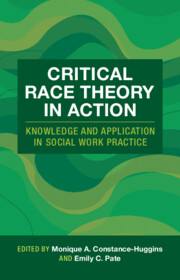Book contents
- Critical Race Theory in Action
- Critical Race Theory in Action
- Copyright page
- Contents
- About the Editors
- Contributors
- Acknowledgments
- Part I Introduction
- Part II Case Studies in Micro-Level Practice
- Part III Case Studies in Mezzo-Level Practice
- Case 3.1 White Privilege at the Work Opportunity Center
- Case 3.2 You Got What?
- Case 3.3 Making Visible the Invisible
- Case 3.4 What Am I Missing?
- Case 3.5 Don’t Forget to Shine!
- Part IV Case Studies in Macro-Level Practice
- Index
- References
Case 3.3 - Making Visible the Invisible
Intersectionality and Counter Storytelling of Black Girls in the Youth Justice System
from Part III - Case Studies in Mezzo-Level Practice
Published online by Cambridge University Press: 25 October 2025
- Critical Race Theory in Action
- Critical Race Theory in Action
- Copyright page
- Contents
- About the Editors
- Contributors
- Acknowledgments
- Part I Introduction
- Part II Case Studies in Micro-Level Practice
- Part III Case Studies in Mezzo-Level Practice
- Case 3.1 White Privilege at the Work Opportunity Center
- Case 3.2 You Got What?
- Case 3.3 Making Visible the Invisible
- Case 3.4 What Am I Missing?
- Case 3.5 Don’t Forget to Shine!
- Part IV Case Studies in Macro-Level Practice
- Index
- References
Summary
This case brings attention to the overrepresentation of Black girls in the juvenile justice system. It highlights this as a multifaceted issue that requires a nuanced understanding of their unique situation, as well as action oriented solutions that recognize the broader structural systems, and inherent power dynamics, in which they live. Through applying the CRT principles of intersectionality and counter storytelling, these experiences are illuminated and disruption of harmful narratives can occur. Such an approach acknowledges the historical context and systemic biases as well as centering their voices, allowing for policies and practices that are more responsive to their needs.
Keywords
Information
- Type
- Chapter
- Information
- Critical Race Theory in ActionKnowledge and Application in Social Work Practice, pp. 81 - 96Publisher: Cambridge University PressPrint publication year: 2025
